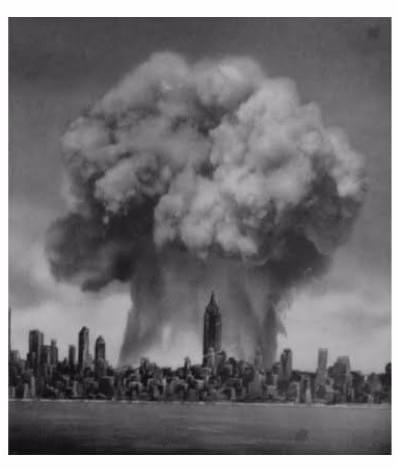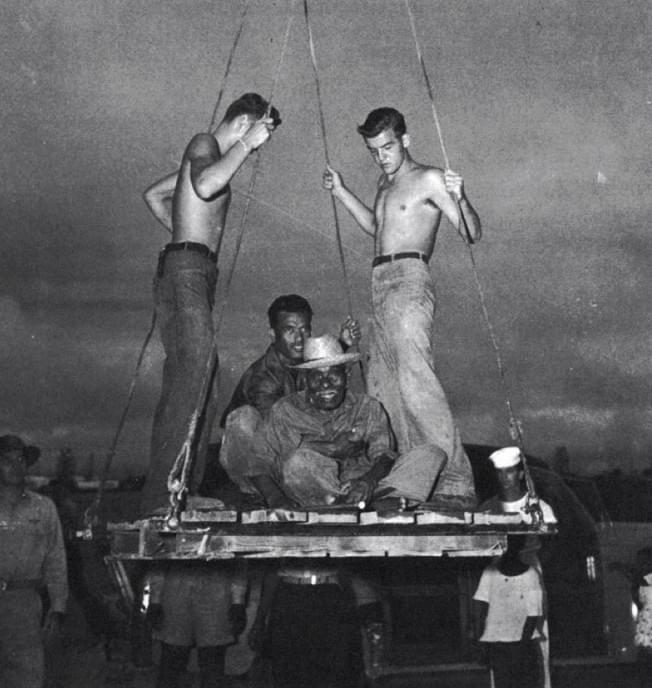
Research
Photo: M.X. Mitchell, 2016, sunset over Majuro lagoon, Long Island, Majuro Atoll, Republic of the Marshall Islands.
Unsettling Sovereignty: International Law, Nuclear Weapons, and US Extraterritorial Power in Postwar Oceania (University of Chicago Press, forthcoming 2026)
What did the United States' nuclear imperialism in Oceania mean for Islanders and for the changing, technologically-contingent shapes of sovereignty after World War II?

"Bikini is not some faraway little atoll pinpointed on an out of the way chart. Bikini is San Francisco Bay, Puget Sound, East River. . . . It isn't just King Juda and his displaced subjects about whom we have to think or to forget."
David M. Bradley, MD, 1946, Observer of Operation Crossroads at Bikini Atoll.
Photo: U.S. Government, 1946, "Bomb versus Metropolis," showing detonation from Bikini Atoll superimposed over the New York City skyline.
My first manuscript project, Unsettling Sovereignty, is a sociolegal history of the United States' nuclear blasting in Aelōn̄-Kein-Ad (the Marshall Islands). Following a series of episodes from the 1942 to the present, I use conflicts over nuclear detonations and contamination as a window onto the shifting shapes of sovereignty after World War II.
Although the United States exercised near complete control over the Marshall Islands following World War II, the islands were not a part of U.S. sovereign territory. Hoping both to foreclose the Pacific from use by hostile nations and to leverage islands for military purposes, U.S. officials created a sui-generis legal entity, a "strategic trusteeship," under the auspices of the United Nations.

Photo: U.S. Trust Territory Government, n.d. 1950s, Map of the Trust Territory of the Pacific Islands.
Under strategic trusteeship, the United States offshored its most devastating nuclear weapons detonations. Between 1946 and 1958, the United States detonated 67 nuclear weapons at Bikini and Enewetak Atolls. By the time the United States entered into the Limited Test Ban Treaty of 1963, halting all above-ground nuclear explosions, fully 80 percent of U.S. atmospheric nuclear yields had been released in the Marshall Islands. After the detonations ceased, Islanders were left to face the enduring consequences on their bodies and ancestral lands and waters.

As the lasting effects of radiological contamination became clear, Marshall Islanders and allies called strategic trusteeship into question, using legal claims and conflicts to test the boundaries of U.S. power. They mobilized laws, Marshallese knowledges, and Western scientific knowledges together to fight for redress and to articulate alternative visions of sovereignty in a world contaminated by traceable technogenic harms.
Photo: U.S. Government, 1946, Bikinian elder Lokiar being loaded onto a U.S. Navy transport ship.
Unsettling Sovereignty uses these legal conflicts to excavate the reshaping of sovereignties in the post-war period. Disputes over nuclear detonations exposed the technologically-contingent extraterritorial expansion of U.S. power, the limits of strategic trusteeship, and the boundaries of Islanders’ belonging. The project establishes Marshall Islanders and their ancestral places as central players in global politics at the intersection between sovereignty and mass-scale technogenic harm—from the enduring legacies of radiological contamination to present-day climate change.
You can read a recent interview about this project on the Pacific Circle blog: https://thepacificcircle.com/2022/03/blog/.

Photo: Trust Territory of the Pacific Islands, 1976, ceremony returning Enewetak Atoll to its people.




